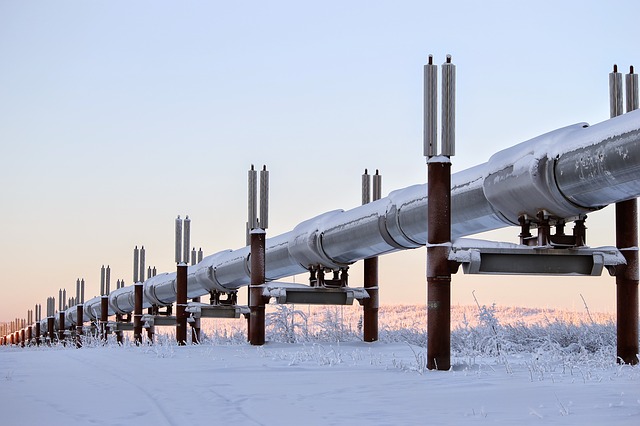The German Green Parliamentary Group “Grüne Bundestagsfraktion” recently issued a position paper on the Nordstream II pipeline project. Below you can find the english translation.
Nord Stream 2 – No Private Matter
In 2015 the Russian energy provider Gazprom, together with E.on, Shell, Engie, BASF/Wintershall and OMV agreed to extend the Nord Stream pipeline so that additional gas can be supplied from Russia to Germany. The pipeline which is 1,200 kilometres long will double the capacity of the existing pipelines by 2019. Even though the first two have so far only been used up to a level of 70%, an additional 55 billion cubic metres of gas per year will be supplied to Germany with Nord Stream 2. In this way the company New European Pipeline AG has been created which has its registered office outside the European Union in Switzerland and owns 50% of the shares in Gazprom.
Regardless of the European Energy Union which intends to have diversification of European sources of raw materials and despite the decisions made at the climate conference in Paris for reduction of CO2 emissions and the associated progressive move away from fossil fuels, the German government is pushing ahead with the project on full steam. In this connection the German Federal Minister of Economics Sigmar Gabriel met with the Russian President Vladimir Putin and the head of Gazprom Alexei Miller in October 2015 for bilateral talks about Germany’s future supply strategy with Russian gas. Chancellor Angela Merkel and German Federal Minister of Economics Sigmar Gabriel have emphasised again and again that Nord Stream 2 is purely a private-sector project over which they have no influence. The fact is, however, that the planned extension of the pipeline is anything other than a purely private matter. The project is associated with substantial costs relating to European policy, geographic strategy and infrastructure. We must also remember that the 50-year project would amount to a fossil lock-in.
Costs relating to European policy
The European Commission has been pursuing the development of a European Energy Union since the start of its term of office in 2014. It has five dimensions which are mutually reinforcing and linked with each other in order to achieve greater energy security, sustainability and competitiveness. Even if the Energy Union is incomplete in its objective and design and is above all in need of greater concentration on a European energy shift and ambitious climate protection, the joint European approach is right.
The purely bilateral Nord Stream project is in conflict with this European approach. Even the fact that the registered office of the consortium is located in Switzerland and the fact that the route is running through the exclusive economic zone shows how determined they are to carry out the project away from any political and legal influence of European participants. This bilateral approach is supported by the German Federal Minister of Economics. During his visit in Moscow he emphasised that “the most important thing is that the regulatory competence must fall within the domain of German bodies” and that “interference from outside” must be avoided and that “the opportunity for political interference in this project” should be curtailed. The project and Gabriel’s comments led to sharp criticism by EU member states, nearly all groups in the EU Parliament, the relevant EU Commissioners and the President of the European Council. The latter expressed doubts as to whether the Nord Stream 2 project is compatible with EU energy regulations because there are reasons to believe that it is incompatible with the terms of the Third Energy Package concerning the decartelisation of providers and pipeline operators. The relevant Energy Commissioner Šefčovič emphasised that Nord Stream 2 is not a project of common interest.
Geostrategic costs
Gazprom already has a market share of approximately 40% in Europe. Russia is by far the most important gas supplier for the EU. Intensified due to the tensions between Europe and Russia over the Ukraine conflict, the stated objective of European energy policy is diversification of European energy sources so that “Europe can quickly switch to other supply channels if the monetary or political price of imports from the East should become too high.”[1] The European union reacted accordingly and developed its own strategy for diversification of its gas sources. The focus here was on liquefied gas. Furthermore, EU Commission representatives emphasised repeatedly that energy efficiency is the top priority. Even if liquefied natural gas (LNG) has so far been more expensive than gas conveyed by pipeline, it has the advantage that in practice it can be obtained anywhere and therefore contributes to further diversification of natural gas supply. The potential for this is available – the capacity of existing LNG terminals in Europe is not yet fully used; according to the Commission they could contribute in order to cover 43% of the European gas requirement.
On the other hand, with the increase of capacity through Nord Stream 2 the current dependency on Gazprom increases whereby the company is already gaining increasing control of the entire gas supply chain in the EU. In 2015, the Russian state-owned company engaged in an asset swap with BASF/Wintershall and thereby secured 20% of German storage capacity – enough to supply 2.2 million single-family homes with gas for one year. And we are talking here about an energy supplier which is not a classic private-sector provider but one which is strongly bound up with the political system and the Russian government. The Russian state owns 50% plus one share in Gazprom. The actions in the Ukraine as well as in the Baltic states shows that import prices for Russian gas are above all politically determined and highly inconsistent for the same product across Europe.
It is clear that other gas sources – such as liquefied gas from Qatar and Algeria or pipeline gas from Azerbaijan (just like oil imports from many countries) – are problematic on the political level. However, the one-sided dependence here is much lower in relation to these countries. Even if we consider their governments to be highly problematic, the EU has not imposed economic sanctions on them as has been the case with Russia. Consequently, the medium-term objective must be to invest in our own real resources, i.e. wind, sun, water and biomass as well as energy conservation instead of importing natural gas costing billions of euros from autocratic regimes.
It is questionable anyway how the Gazprom project could possibly be harmonised with the German policy relating to Russia and Ukraine. With the increase in capacity to over 100 billion cubic metres the transport routes for Russian gas within Europe would change substantially because no increase in demand for gas is to be expected and the international gas markets are characterised by massive oversupply[2]. Gas consumption in the EU is already stagnating and it will decrease due to the change in energy policy. Accordingly, Gazprom has already announced that it will stop its gas supplies to the EU via the Ukraine from 2019, i.e. from the planned date for Nord Stream 2 to go live.
In this way Ukraine, which is already heavily in debt, would lose approximately two billion euros. So far it is unclear how this loss of revenue for the country will be compensated. Although it has been stated that even after 2019 gas will be supplied by the Ukraine, agreements between the Ukraine and Russia about transit fees with Nord Stream 2 are encumbered with difficulties in addition to the current conflict.
Furthermore, it is clear that the Ukraine needs to become more independent from imports and transit revenues for which reason it cannot be in the interest of Germany and the EU to destabilise it further. Nord Stream 2 is undermining the efforts to modernise the extremely dilapidated Ukrainian gas network. It is clear that the additional uncertainty about the future of Ukraine gas transit will lead to a further fall in investment.
Infrastructure costs
The consortium expects costs of approximately eight billion euros for the construction of the Nord Stream 2 pipeline 30% of which will be covered by equity capital and 70% by external funds with no dependence on public funds. However, what is left out of account is the fact that although the Nord Stream pipeline is to end in Lubmin, supply and forwarding of gas will not. The increase in capacity associated with Nord Stream also entails massive new investments for the Baltic Sea Pipeline Link (OPAL) and the North European Gas Pipeline (NEGP) which distribute Russian gas in Europe because their current capacities are only geared to Nord Stream 1. It has not yet been clarified who will undertake this enhancement of capacity and whether public funds, e.g. German or European subsidies will have to be included in the financing. It is, however, clear that the shift of Russian gas supplies to northern Germany will lead to changes in the gas supply infrastructure and the gas supply security in the whole of Europe and that this will necessitate massive investments which could, for example, affect the interconnectivity objective and in the end be detrimental to consumers.
Furthermore, on account of the political costs already mentioned the project would only be possible with a buy-out. There is already a rumour that the Ukraine could undertake the function of gas storage and Poland could, for example, be compensated by modernisation of its infrastructure. But this too costs money.
Costs relating to climate policy
At the climate conference in Paris 195 countries made an internationally binding commitment to limit global warming to a level significantly below 2°. The new climate agreement also stipulates that the world must become neutral in terms of greenhouse gas emissions in the second half of the century. For Europe this means switching exclusively to renewable energies by 2050. On the way to this objective modern gas power plants and gas heating systems for the purpose of providing heat in basements in Germany play a special role on account of their flexibility. The central issue is, however, that it is a short and in particular a flexible bridge and that it must not turn into a new natural gas lock-in in the context of the overdue exit from coal.
According to the European Commission the EU has an annual aggregate demand for gas of approximately 400 billion cubic metres. The European Court of Auditors as well as other experts have criticised this estimation as substantially excessive. Estimations are equally divergent concerning the new foreign demand to compensate for the decline in Norwegian and Dutch gas. After all, this depends above all on the progress of renewable energies and energy efficiency. A 1% increase in energy efficiency results in a 2.6 % reduction in demand for gas. Or to put it differently, the greater the investment in the sphere of fossil fuels, the greater the danger of a wrong turn in energy policy.
Against this background it is counter-productive at this point – 35 years before the decarbonisation target – to invest in a large fossil fuel project which, according to the Nord Stream consortium, has a 50-year timeframe.
Instead, the aim must be to create an infrastructure that does not obstruct climate goals. To meet the current demand for natural gas which will decrease in the future, the German government must become a reliable partner in the process of improving the supply of gas in Europe. This means pushing ahead with the development of interconnectors, liquid hubs and an improved LNG strategy for the transition to 100% renewable energy in Europe as well as integration into a power-to-gas strategy in accordance with the climate goals.
Instead of using Nord Stream 2 to cement a fossil infrastructure and with it a fossil-fuel dependency over the decades we need to increase provision of energy from renewable sources as well as measures to reduce demand. This means an ambitious strategy for energy-efficient heating and cooling to support the replacement of inefficient heating systems and the switch from natural gas to renewable energy sources (solar thermal energy, geothermal energy, sustainable biomass, power-to-x). For this purpose the European Union should use financial instruments, guarantee funds and technical assistance to stimulate investment in energy efficiency with a de-risking strategy aimed primarily at Central and South-Eastern European countries as has already been proposed in the declaration in Luxembourg.
Conclusion
Although Nord Stream 2 may be financially self-sufficient as a pipeline project, the negative secondary political and economic costs will be immense. It is also incompatible with the European decarbonisation obligations in accordance with the Paris agreement and it cements fossil-fuel dependency. It weakens the further development of the European Energy Union and reduces European competitiveness because it makes the EU dependent on just one provider which could in future use its monopoly as a way of applying pressure. Furthermore, Nord Stream 2 cannot be examined in isolation from the challenges of security policy in the Ukraine. All this cannot be in the interest of Germany and the EU.
For these reasons we will not take a politically indifferent stance in relation to the project as the German government is currently trying to suggest. Instead we will decisively oppose the development of this unnecessary infrastructure which is harmful to the environment. We are in favour of our own true energy sources, i.e. sun, water, wind and sustainable biomass. Not only are they now producing electricity more cost-effectively than new gas or coal-fired power stations, they also make us independent of expensive energy imports.
[1] http://ec.europa.eu/priorities/energy-union-and-climate_pt?2nd-language=de
[2] http://www.gruene- bundestag.de/fileadmin/media/gruenebundestag_de/themen_az/energie/PDF/kurzstudie-gaspreise-2015- 2016.pdf


















